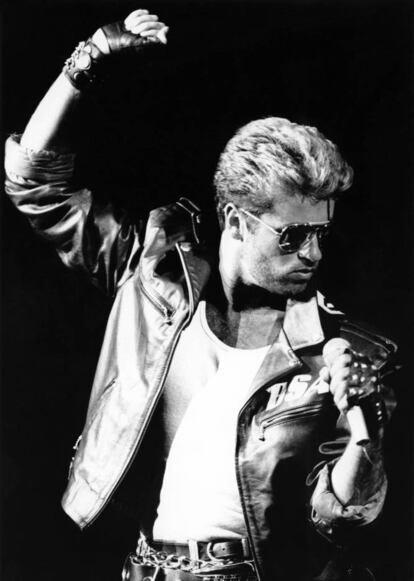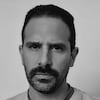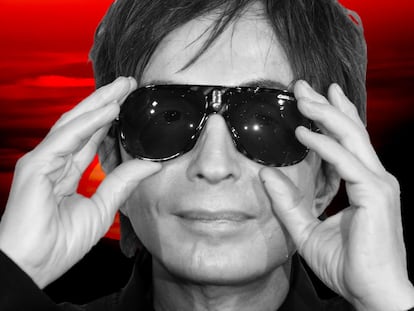George Michael revisited: binge-eating ice cream, sex and ecstasy
A new book and documentary examine the life of the former Wham! frontman, who would now be 59

George Michael abhorred fame and avoided interviews. Over his 30-year career, the singer of Faith released only four studio albums as a solo artist. But his figure left a lasting impact on popular culture. The public’s fascination with him lingers even today, as demonstrated by the recent release of both a documentary and a book about his life, just when the artist would have turned 59. The two works depict the pop star’s life from dramatically different perspectives.
The musician himself worked on the film George Michael: Freedom Uncut with his former collaborator, David Austin. It follows the career of one of the best voices in pop, starting in the 1980s and ending in 2016, the year of his death. Narrated in the first person, the documentary gives a partial glimpse of the star. In contrast, journalist James Gavin’s book George Michael: A Life explores the singer’s dark side in great detail. The biography chronicles Michael’s addiction to GHB, also known as liquid ecstasy, his depression and his dependence on sex. According to the account, Michael spent his later years sinking into drugs and prostitution and alienating his friends, including Andrew Ridgeley, the other half of Wham!. Gavin spoke with more than 200 friends and acquaintances of the artist, resulting in a portrayal of an emotionally fragile and insecure man. According to the author’s thesis, which several friends corroborate but his family denies, the performer died not of a heart condition, as was said at the time, but of an intentional overdose: suicide.
The documentary film focuses on the 1980s and 90s, the artist’s creative peak. The book, meanwhile, primarily describes his last years of life, when he made headlines more for his arrests than for his music. Both are pieces of a puzzle that the artist created before the public over three decades.
It is difficult to understand the career of George Michael, who would turn 59 this June 25, without delving into his biography. Born Georgios Kyriacos Panayiotou in 1963, he rose to worldwide fame alongside his school friend Andrew Ridgeley. Together they formed Wham!, a group adored by teenage girls and despised by critics. Michael enjoyed a global fame that he never wanted. He felt undervalued as an artist, relegated to the status of a teen star. He also didn’t take well to playing the role of a heterosexual idol in order to sell records to the female public. He was ready to embrace his sexuality, but society wasn’t. At the time, both Elton John and Freddy Mercury were married to women. In Spain, Miguel Bosé walked hand in hand with Ana Obregón. A mainstream artist couldn’t afford to be gay.

Still, George Michael represented his sexuality with a certain impudent joy in public. In his later years, looking back, Michael said his sexuality had been an enigma, even to him, but his music was always honest. “I do want people to know the songs I wrote when I was with women were really about women and the songs that I’ve written since have been fairly obviously about men,” he said. “So when it comes to my work I’ve never been reticent about defining my sexuality.” George Michael was sex. His music was too.
On his first solo album, he broke away from his good-boy image to present himself as a sexually liberated man–in a trajectory later imitated by many pop artists, including Britney Spears and Christina Aguilera. His first solo song, I Want Your Sex, was dedicated to a man, but his then-girlfriend, makeup artist Kathy Jeung, appeared in the music video. “[Kathy] was in love with me but she knew that I was in love with a guy at that point in time. I was still saying I was bisexual,” he explained in a 2004 interview with the British magazine Attitude. The song caused controversy for defending promiscuity in the harshest years of AIDS, and its explicitly sexual lyrics were censored on several radio networks.
In the music video for his second single, Faith, Michael played the role of the American macho, wearing a leather jacket, jeans and cowboy boots, combined with close-ups of his butt swaying to the beat. The singer was asserting himself as a mature composer. At the same time, he was sexualizing himself. The song made him a worldwide success. He began to rub shoulders with pop royalty, including Michael Jackson, Madonna and Prince. At that time, pop stars were at the heart of popular culture. But only George Michael used his role to confront record companies and eventually renounce media overexposure.
If singers were kings, MTV was their palace. In the 1990s, a good music video could boost a song’s sales and its artist’s fame. That’s when George Michael decided to disappear. He barely promoted his long-awaited second album, much less commercial than the first. Its first music video, Freedom, featured the five most important top models of the moment. The video was directed by first-timer David Fincher, who before revolutionizing Hollywood already revolutionized MTV. It has gone down in history as one of the best video clips of all time.
Freedom: Uncut, the new documentary, focuses on that creative stage of the singer. Some of the participants in that video, such as Cindy Crawford, Kate Moss and Naomi Campbell, give interviews about Michael, and the film includes discarded footage that Fincher did not use. While the documentary focuses on his art, it also touches on aspects of his personal life, including the deaths of his mother and Anselmo Feleppa, his great love, who died of complications from AIDS in 1993.
The two deaths had a devastating effect on Michael, and they triggered the spiral that Gavin focuses on in his book. The author calls the singer a “pathetic, lonely and broken figure.”
George Michael did not publicly come out of the closet. He was wrenched out in the most shameful way possible. In September 1998, a plainclothes officer made a pass at him in a public restroom in Los Angeles, California. When the artist played along, he was arrested. Searching him, police found marijuana and crack. The former leader of Wham! was fined only $810, but the media’s penalty was devastating. Tabloids on both sides of the Atlantic lashed out at him. It was no longer the 1980s, but a scandal like that could still end anyone’s career. He explained himself the best way he could: with a song. The video clip for Outside, the single from his greatest hits album, was based on the famous incident. It portrays several men dressed as police kissing in the bathroom of a club, while a press helicopter records different couples having sex. Michael took control of the narrative, as sexual and as honest as ever.

But no song could silence the news that followed. A few months later, the musician was arrested again after a car accident. The police found him “drenched in sweat” with “eyes open and pupils dilated.” It was his seventh arrest in 12 years. In the biography, Gavin expands on this stage, at the time portrayed by the press at the time in a disjointed and sensationalistic way. The author places it in the context of the impulses of a depressed, frustrated man taking refuge in drugs and sex. “For Michael, GHB seemed heaven-sent,” the journalist writes about the drug, a central nervous system depressant closely associated with sex parties. “Apart from fueling his sexual compulsiveness, it made a depressed, self-hating man feel attractive. It brought joy where there was little. GHB gave him confidence … but it also took him to a new and terrifying level of self-destruction.”
Gavin describes one of the music industry’s brightest stars as a lonely, friendless man, secluded in his mansion. He spent his days watching episodes of his favorite soap opera, Coronation Street, while binging on Häagen-Dazs ice cream and junk food and using GHB. The author writes that the singer held parties with prostitutes and large amounts of drugs in his mansion in north London.
The journalist’s description is consistent with statements made this week by Kenny Goss, who had a relationship with the singer between 1996 and 2009. In an interview on the English program Piers Morgan Uncensored, the art dealer recounted that everyone around him knew that Michael would die soon. “I spent a lot of time worrying about him,” he recalled. “What’s the line he says in one of his songs? He says, ‘I can see it in your eyes when you look at me that way, it tears me in two.’ And it really did.”
George Michael died on Christmas Day, 2016. The official report says that the death was due to heart failure. His fans remembered him with Last Christmas. a song that many read as a Christmas carol, but which actually tells a tragic story about heartbreak and distrust. “All my songs are autobiographical,” the singer used to say.
Tu suscripción se está usando en otro dispositivo
¿Quieres añadir otro usuario a tu suscripción?
Si continúas leyendo en este dispositivo, no se podrá leer en el otro.
FlechaTu suscripción se está usando en otro dispositivo y solo puedes acceder a EL PAÍS desde un dispositivo a la vez.
Si quieres compartir tu cuenta, cambia tu suscripción a la modalidad Premium, así podrás añadir otro usuario. Cada uno accederá con su propia cuenta de email, lo que os permitirá personalizar vuestra experiencia en EL PAÍS.
¿Tienes una suscripción de empresa? Accede aquí para contratar más cuentas.
En el caso de no saber quién está usando tu cuenta, te recomendamos cambiar tu contraseña aquí.
Si decides continuar compartiendo tu cuenta, este mensaje se mostrará en tu dispositivo y en el de la otra persona que está usando tu cuenta de forma indefinida, afectando a tu experiencia de lectura. Puedes consultar aquí los términos y condiciones de la suscripción digital.











































